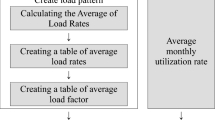Abstract
Transformer insulation aging is a critical issue for both reliable and economic operations, and for planning of electrical systems. As insulation aging depends on the hottest-spot temperature, transformer management can be improved with a suitable model for temperature estimation and prediction. However, the temperature inside transformers varies dynamically because of changes in both the cooling conditions and the load cycles. Hence, this paper presents an algorithm to estimate and predict the hottest-spot in dry-type distribution transformers, so that their capability and insulation life can be assessed. This procedure is focused on transformers used to directly connect PV-inverters to the grid in order to consider the uncontrolled power generation of distribution PV-systems. To implement the algorithm, it is assumed that records of ambient temperature, PV-system power generation cycle and winding temperature are available. With these data, the parameters of an equivalent thermal circuit are fitted in order to dynamically model the transformer hottest-spot. The method was validated using twelve-day records of a \(70\,\hbox { kW}_{\mathrm{p}}\) PV-generation system connected to a \({75}\,\hbox {kVA}\) dry-type transformer. Results show that an enhancement in the hot-spot estimation is reached, and an assessment of the performance in real-time monitoring of the transformer capacity is achieved employing the proposed algorithm.











Similar content being viewed by others
References
Alvarez DL, Rivera SR, Mombello EE (2019) Transformer thermal capacity estimation and prediction using dynamic rating monitoring. IEEE Trans Power Deliv 34(4):1695–1705. https://doi.org/10.1109/TPWRD.2019.2918243
Alvarez DL, da Silva FF, Mombello EE, Bak CL, Rosero JA (2018) Conductor temperature estimation and prediction at thermal transient state in dynamic line rating application. IEEE Trans Power Deliv 33(5):2236–2245. https://doi.org/10.1109/TPWRD.2018.2831080
Awadallah MA, Xu T, Venkatesh B, Singh BN (2016) On the effects of solar panels distribution transformers. IEEE Trans Power Deliv 31(3):1176–1185. https://doi.org/10.1109/TPWRD.2015.2443715
Blanco Alonso PE, Meana-Fernández A, Fernández Oro JM (2017) Thermal response and failure mode evaluation of a dry-type transformer. Appl Therm Eng 120:763–771. https://doi.org/10.1016/j.applthermaleng.2017.04.007
Bracale A, Caramia P, Carpinelli G, De Falco P (2020) SmarTrafo: a probabilistic predictive tool for dynamic transformer rating. IEEE Trans Power Deliv. https://doi.org/10.1109/TPWRD.2020.3012180
C57.134\(^{{\rm TM}}\): IEEE guide for determination of hottest-spot temperature in dry-type transformers (2013)
C57.159\(^{{\rm TM}}\): IEEE guide on transformers for application in distributed photovoltaic (DPV) power generation systems (2016)
C57.96\(^{{\rm TM}}\): IEEE guide for loading dry-type distribution and power transformers ieee power and (2013)
Chen W, Su X (2013) Application of Kalman filter to hot-spot temperature monitoring in oil-immersed power transformer. IEEJ Trans on Electri Electron Eng 8(4):322–327. https://doi.org/10.1002/tee.21862
Dong M (2020) A data-driven long-term dynamic rating estimating method for power transformers. IEEE Trans Power Deliv. https://doi.org/10.1109/tpwrd.2020.2988921
Eslamian M, Vahidi B, Eslamian A (2011) Thermal analysis of cast-resin dry-type transformers. Energy Convers Manag 52(7):2479–2488. https://doi.org/10.1016/j.enconman.2011.02.006
IEEE Std C57.110\(^{{\rm TM}}\)-2018 (Revision of IEEE Std C57.110-2008): IEEE recommended practice for establishing liquid-immersed and dry-type power and distribution transformer capability when supplying nonsinusoidal load currents (2018). https://doi.org/10.1109/IEEESTD.2018.8511103
Lee M, Abdullah HA, Jofriet JC, Patel D (2010) Thermal modeling of disc-type winding for ventilated dry-type transformers. Electr Power Syst Res 80(1):121–129. https://doi.org/10.1016/j.epsr.2009.08.007
Lu H, Borbuev A, Jazebi S, Hong T, de León F (2018) Smart load management of distribution-class Toroidal transformers using a dynamic thermal model. IET Gener Transm Distrib 12(1):142–149. https://doi.org/10.1049/iet-gtd.2017.0360
Mondol JD, Yohanis YG, Norton B (2006) Optimal sizing of array and inverter for grid-connected photovoltaic systems. Solar Energy 80(12):1517–1539. https://doi.org/10.1016/j.solener.2006.01.006
Pezeshki H, Wolfs PJ, Ledwich G (2014) Impact of high PV penetration on distribution transformer insulation life. IEEE Trans Power Deliv 29(3):1212–1220. https://doi.org/10.1109/TPWRD.2013.2287002
Salama MM, Mansour DEA, Abdelmakasoud SM, Abbas AA (2019) Impact of optimum power factor of PV-controlled inverter on the aging and cost-effectiveness of oil-filled transformer considering long-term characteristics. IET Gener Transm Distrib 13(16):3574–3582. https://doi.org/10.1049/iet-gtd.2019.0409
Simon D (2006) Nonlinear Kalman filtering, chapter 13. In: Simon D (ed) Optimal state estimation Kalman, H infinity, and nonlinear approaches. Wiley, New Jersey, pp 395–426. https://doi.org/10.1002/0470045345
Susa D, Lehtonen M (2006) Dynamic thermal modeling of power transformers: further development-Part I. IEEE Trans Power Deliv 21(4):1961–1970. https://doi.org/10.1109/TPWRD.2005.864069
Susa D, Lehtonen M, Nordman H (2005) Dynamic thermal modelling of power transformers. IEEE Trans Power Deliv 20(1):197–204. https://doi.org/10.1109/TPWRD.2004.835255
Swift G, Molinski T, Bray R, Menzies R (2001) A fundamental approach to transformer thermal modeling. II. Field verification. IEEE Trans Power Deliv 16(2):176–180. https://doi.org/10.1109/61.915479
Tellez S, Alvarez D, Montano W, Vargas C, Cespedes R, Parra E, Rosero J (2014) National laboratory of smart grids (LAB+i) at the National University of Colombia-Bogota campus. In: 2014 IEEE PES transmission and distribution conference and exposition- Latin America (PES T&D-LA), pp 1–6. IEEE . https://doi.org/10.1109/TDC-LA.2014.6955185
Zhang X, Qian S, Xu Y, Marek R, Lei Q (2020) Overload distribution transformer with natural ester and aramid-enhanced cellulose. IEEE Trans Power Deliv. https://doi.org/10.1109/TPWRD.2020.3015797
Zhou L, Wang L, Tang H, Wang J, Guo L, Cui Y (2018) Oil exponent thermal modelling for traction transformer under multiple overloads. IET Gener Transm Distrib 12(22):5982–5989. https://doi.org/10.1049/iet-gtd.2018.5084
Author information
Authors and Affiliations
Corresponding author
Ethics declarations
Conflict of interest
The authors declare that they have no conflict of interest.
Additional information
Publisher's Note
Springer Nature remains neutral with regard to jurisdictional claims in published maps and institutional affiliations.
Appendix
Appendix
In order to implement the proposed EKF, the following set of equations were derived, where the subscript R is related to the rated condition.
Rights and permissions
About this article
Cite this article
Alvarez, D.L., Restrepo, J., da Silva, F.F. et al. Load capability estimation of dry-type transformers used in PV-systems by employing field measurements. Electr Eng 103, 1055–1065 (2021). https://doi.org/10.1007/s00202-020-01148-7
Received:
Accepted:
Published:
Issue Date:
DOI: https://doi.org/10.1007/s00202-020-01148-7




